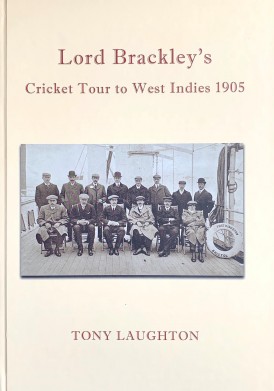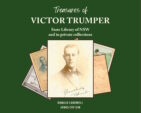Lord Brackley’s Cricket Tour to West Indies 1905
Archie Mac |Published: 2021
Pages: 113
Author: Laughton, Tony
Publisher: Boundary Books
Rating: 4 stars

It is hard to imagine where the Golden Age of cricket fan would be without publishers like Boundary Books, or for that matter author, Tony Laughton. I think the book under review is the third collaboration between publisher and author. As expected it is another treasure for the lovers of this period in cricket history.
As with all treasures it is hard to track down, with just 70 numbered copies produced, which I feared had sold out. Good news though, CWs friend Roger Page, who can be contacted on (03) 9435 6332 or via email at rpcricketbooks@iprimus.com.au still has a few copies for sale.
Lord Brackley’s Cricket Tour of West Indies 1905 is basically divided into two parts. The first contains pen portraits of all the tourists. These are most entertaining and Laughton has clearly gone to considerable effort to track down pertinent facts. Each tourist is provided two to four pages and given that many of those who toured are not well known to the cricket fan, the decision to include the pen portraits at the front of the book rather than at the end was a wise and appreciated decision.
Even those who know their Golden Age players will be hard pressed to place the majority of the 1905 team. The only two professionals chosen to play will be the best known to readers. Ernie Hayes and George Thompson were consistent rather than brilliant county pros, although both were good enough to play Test cricket. From a cricketing sense the best known amateurs on the tour were – Teddy Wynyard, the adventuring author ‘Hex’ Hesketh-Prichard and perhaps the last of the great lobsters, George Simpson-Hayward. In the end these five between them dominated the batting and bowling figures on the tour.
A number of the players involved in the tour served in the armed forces. Surprisingly given the casualty rates in the Great War all of those from the tour involved in the ‘war to end all wars’, made it through relatively, physically at least, unscathed.
The second half of the book, which covers the tour, is not quite as strong as the first half. This is mainly due to the decision to rely on contemporary newspaper reports by Wynyard and Hayes, as well as extracts from the book published at the end of the tour by vice captain Cyril Foley. I would much rather that Laughton had injected his own opinions about the tour and a few of the controversies.
One controversy that is not adequately explained is a slight by one of the West Indies players during a match. The slight saw Lord Brackley refuse to allow this player to take part in the second ‘Test’ match. In the end Brackley relented, however discussions meant the match started an hour late. Perhaps the author had no further information to add. Still I would have liked to know this fact, and also his opinion on what the slight may have been.
The two matches against All West Indies were not awarded Test status although the English team thought they were playing in Tests, and certainly they appear much more meriting of Test status then some of the early matches between England and South Africa. The second game against All West Indies was a classic match and would deservedly be better remembered if given Test status.
Lord Brackley only played 12 First Class matches so his main claim to the hegemony role was one of social status, which has not always equated to a good cricket captain. It seems however that all those involved in the trip carried fond memories of the tour throughout their lives, and this in large part seems to have been due to the captain.
If you like the Golden Age of cricket, or just like to look back at another time in history, I can highly recommend Lord Brackley’s Cricket Tour of West Indies 1905. Remember Roger Page still has a few copies available.






Leave a comment